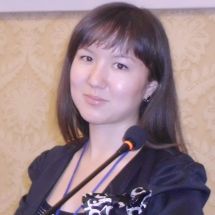stdClass Object
(
[nazev] => University of Chemistry and Technology, Prague
[adresa_url] => www.vscht.cz
[api_hash] =>
[seo_desc] =>
[jazyk] =>
[jednojazycny] =>
[barva] =>
[indexace] => 1
[obrazek] => 0005~~Cwt29gjRTcsv0vV3BwA.jpg
[ga_force] =>
[cookie_force] =>
[secureredirect] =>
[google_verification] =>
[ga_account] =>
[ga_domain] =>
[ga4_account] =>
[gtm_id] => GTM-MLPTFM
[gt_code] =>
[kontrola_pred] =>
[omezeni] => 0
[pozadi1] =>
[pozadi2] =>
[pozadi3] =>
[pozadi4] =>
[pozadi5] =>
[robots] =>
[htmlheaders] =>
[newurl_domain] => 'www.vscht.cz'
[newurl_jazyk] => 'en'
[newurl_akce] => '[en]'
[newurl_iduzel] =>
[newurl_path] => 1/4111/959
[newurl_path_link] => Odkaz na newurlCMS
[iduzel] => 959
[platne_od] => 17.03.2020 10:06:00
[zmeneno_cas] => 17.03.2020 10:06:41.987473
[zmeneno_uzivatel_jmeno] => Jan Kříž
[canonical_url] =>
[idvazba] => 1237
[cms_time] => 1714176696
[skupina_www] => Array
(
)
[slovnik] => stdClass Object
(
[logo] =>  [aktualizovano] => Updated
[autor] => Author
[drobecky] => You are here: UCT Prague
[more_info] => More Information
[paticka_adresa] => CONTACT
[aktualizovano] => Updated
[autor] => Author
[drobecky] => You are here: UCT Prague
[more_info] => More Information
[paticka_adresa] => CONTACT
UCT Prague
Technická 5
166 28 Prague 6 – Dejvice
Identification No.: 60461373
VAT: CZ60461373
Copyright: UCT Prague
Information provided by the Department of Communication.
Sitemap
[paticka_budova_1_nadpis] => NATIONAL LIBRARY OF TECHNOLOGY
[paticka_budova_a_nadpis] => BUILDING A
[paticka_budova_a_popis] => Rector,
Department of Communication,
Centre for Information Services
[paticka_budova_b_nadpis] => BUILDING B
[paticka_budova_b_popis] => Dean’s Offices:
FCT,
FET,
FFBT,
FCE,
Department of Education,
Computer Centre,
Department of International Relations,
Registrar
[paticka_budova_c_nadpis] => BUILDING C
[paticka_budova_c_popis] => UCT Prague Childcare Centre,
General Practitioner
[paticka_odkaz_mail] => mailto:info@vscht.cz
[social_fb_odkaz] => https://www.facebook.com/vscht
[social_fb_title] => Facebook - UCT Prague
[social_tw_odkaz] => https://twitter.com/vscht
[social_tw_title] => Twitter - UCT Prague
[social_yt_odkaz] => https://www.youtube.com/user/VSCHTPraha
[social_yt_title] => YouTube - UCT Prague
[stahnout] => Download
[top_login] => Sign In
[top_search_placeholder] => Search...
[paticka_budova_1_popis] =>
[paticka_budova_2_nadpis] => CAFÉ CARBON
[paticka_budova_2_popis] =>
[zobrazit_kalendar] => Read Calendar
[logo_href] => /
[google_search] => 001523547858480163194:u-cbn29rzve
[adresa_url] =>
[archiv_novinek] => News Archive
[submenu_novinky_rok_title] => Read News from All Year
[paticka_mapa_alt] =>
[zobrazit_vice_kalendar] => More →
[den_kratky_2] => Tue
[den_kratky_5] => Fri
[den_kratky_3] => Wed
[novinky_kategorie_1] => UCT Events
[novinky_kategorie_2] => Important Dates
[novinky_kategorie_3] => Student Events
[novinky_kategorie_4] => Fun
[novinky_kategorie_5] => Science
[novinky_archiv_url] => /news
[novinky_servis_archiv_rok] => Annual Archive
[novinky_servis_nadpis] => News Settings
[novinky_dalsi] => More News
[novinky_archiv] => News Archive
[den_kratky_4] => Thurs
[intranet_odkaz] => https://intranet.vscht.cz/
[intranet_text] => Intranet
[den_kratky_1] => Mon
[logo_mobile_href] => /
[logo_mobile] =>  [mobile_over_nadpis_menu] => Menu
[mobile_over_nadpis_search] => Search
[mobile_over_nadpis_jazyky] => Languages
[mobile_over_nadpis_login] => Login
[menu_home] => Homepage
[zobraz_desktop_verzi] => switch to desktop version
[zobraz_mobilni_verzi] => switch to mobile version
[den_kratky_0] => Sun
[paticka_mapa_odkaz] => /contact/campus-and-directions
[den_kratky_6] => Sat
[nepodporovany_prohlizec] => For full access, please use different browser.
[dokumenty_kod] => Code
[dokumenty_nazev] => Name
[dokumenty_platne_od] => Valid from
[dokumenty_platne_do] => Expiration
[preloader] => Please wait...
[novinka_publikovano] => Published:
[novinka_datum_konani] => Date of event:
[novinky_kategorie_7] =>
[novinky_servis_kategorie_vse] => vše
[novinky_servis_archiv_submit] => Filtrovat
[novinky_filtered_empty] => Pri zvolenem filtru, v teto kategorii nejsou zadne aktualne platne aktuality...
[social_in_odkaz] => https://www.instagram.com/vschtpraha
[social_in_title] => Instagram - UCT Prague
[hledani_nadpis] => Search
[hledani_nenalezeno] => Not found
[hledani_vyhledat_google] => Search with Google
[social_li_odkaz] =>
)
[poduzel] => stdClass Object
(
[1016] => stdClass Object
(
[obsah] =>
[poduzel] => stdClass Object
(
[1614] => stdClass Object
(
[obsah] =>
[iduzel] => 1614
[canonical_url] => //www.vscht.cz
[skupina_www] => Array
(
)
[url] =>
[sablona] => stdClass Object
(
[class] =>
[html] =>
[css] =>
[js] =>
[autonomni] =>
)
)
[1612] => stdClass Object
(
[obsah] =>
[iduzel] => 1612
[canonical_url] => //www.vscht.cz
[skupina_www] => Array
(
)
[url] =>
[sablona] => stdClass Object
(
[class] =>
[html] =>
[css] =>
[js] =>
[autonomni] =>
)
)
[1613] => stdClass Object
(
[obsah] =>
[iduzel] => 1613
[canonical_url] => //www.vscht.cz
[skupina_www] => Array
(
)
[url] =>
[sablona] => stdClass Object
(
[class] =>
[html] =>
[css] =>
[js] =>
[autonomni] =>
)
)
)
[iduzel] => 1016
[canonical_url] =>
[skupina_www] => Array
(
)
[url] =>
[sablona] => stdClass Object
(
[class] =>
[html] =>
[css] =>
[js] =>
[autonomni] =>
)
)
[1017] => stdClass Object
(
[obsah] =>
[poduzel] => stdClass Object
(
[1579] => stdClass Object
(
[nazev] => Homepage
[seo_title] => Homepage
[seo_desc] => University of Chemistry and Technology, Prague
[autor] =>
[autor_email] =>
[obsah] =>
[urlnadstranka] =>
[ogobrazek] =>
[pozadi] =>
[iduzel] => 1579
[canonical_url] =>
[skupina_www] => Array
(
)
[url] => /home
[sablona] => stdClass Object
(
[class] => stranka_novinky
[html] =>
[css] =>
[js] =>
[autonomni] => 1
)
)
[2409] => stdClass Object
(
[nazev] => The University of Chemistry and Technology Prague
[seo_title] => About
[seo_desc] => Basic information about University of Chemistry and Technology Prague
[autor] =>
[autor_email] =>
[obsah] =>
[mobile_over_nadpis_menu] => Menu
[mobile_over_nadpis_search] => Search
[mobile_over_nadpis_jazyky] => Languages
[mobile_over_nadpis_login] => Login
[menu_home] => Homepage
[zobraz_desktop_verzi] => switch to desktop version
[zobraz_mobilni_verzi] => switch to mobile version
[den_kratky_0] => Sun
[paticka_mapa_odkaz] => /contact/campus-and-directions
[den_kratky_6] => Sat
[nepodporovany_prohlizec] => For full access, please use different browser.
[dokumenty_kod] => Code
[dokumenty_nazev] => Name
[dokumenty_platne_od] => Valid from
[dokumenty_platne_do] => Expiration
[preloader] => Please wait...
[novinka_publikovano] => Published:
[novinka_datum_konani] => Date of event:
[novinky_kategorie_7] =>
[novinky_servis_kategorie_vse] => vše
[novinky_servis_archiv_submit] => Filtrovat
[novinky_filtered_empty] => Pri zvolenem filtru, v teto kategorii nejsou zadne aktualne platne aktuality...
[social_in_odkaz] => https://www.instagram.com/vschtpraha
[social_in_title] => Instagram - UCT Prague
[hledani_nadpis] => Search
[hledani_nenalezeno] => Not found
[hledani_vyhledat_google] => Search with Google
[social_li_odkaz] =>
)
[poduzel] => stdClass Object
(
[1016] => stdClass Object
(
[obsah] =>
[poduzel] => stdClass Object
(
[1614] => stdClass Object
(
[obsah] =>
[iduzel] => 1614
[canonical_url] => //www.vscht.cz
[skupina_www] => Array
(
)
[url] =>
[sablona] => stdClass Object
(
[class] =>
[html] =>
[css] =>
[js] =>
[autonomni] =>
)
)
[1612] => stdClass Object
(
[obsah] =>
[iduzel] => 1612
[canonical_url] => //www.vscht.cz
[skupina_www] => Array
(
)
[url] =>
[sablona] => stdClass Object
(
[class] =>
[html] =>
[css] =>
[js] =>
[autonomni] =>
)
)
[1613] => stdClass Object
(
[obsah] =>
[iduzel] => 1613
[canonical_url] => //www.vscht.cz
[skupina_www] => Array
(
)
[url] =>
[sablona] => stdClass Object
(
[class] =>
[html] =>
[css] =>
[js] =>
[autonomni] =>
)
)
)
[iduzel] => 1016
[canonical_url] =>
[skupina_www] => Array
(
)
[url] =>
[sablona] => stdClass Object
(
[class] =>
[html] =>
[css] =>
[js] =>
[autonomni] =>
)
)
[1017] => stdClass Object
(
[obsah] =>
[poduzel] => stdClass Object
(
[1579] => stdClass Object
(
[nazev] => Homepage
[seo_title] => Homepage
[seo_desc] => University of Chemistry and Technology, Prague
[autor] =>
[autor_email] =>
[obsah] =>
[urlnadstranka] =>
[ogobrazek] =>
[pozadi] =>
[iduzel] => 1579
[canonical_url] =>
[skupina_www] => Array
(
)
[url] => /home
[sablona] => stdClass Object
(
[class] => stranka_novinky
[html] =>
[css] =>
[js] =>
[autonomni] => 1
)
)
[2409] => stdClass Object
(
[nazev] => The University of Chemistry and Technology Prague
[seo_title] => About
[seo_desc] => Basic information about University of Chemistry and Technology Prague
[autor] =>
[autor_email] =>
[obsah] => The University of Chemistry and Technology, Prague is a natural centre of first-rate study and research in the area of chemistry in Czechia and is one of the country's largest educational and research institutions focused on technical chemistry, chemical and biochemical technologies, material and chemical engineering, food chemistry, and environmental studies.
UCT Prague - A challenge that pays off
[urlnadstranka] => [ogobrazek] => [pozadi] => [iduzel] => 2409 [canonical_url] => [skupina_www] => Array ( ) [url] => /about-us [sablona] => stdClass Object ( [class] => stranka_submenu [html] => [css] => [js] => [autonomni] => 1 ) ) [12965] => stdClass Object ( [nazev] => Faculties and Departments [seo_title] => Faculties and Departments [seo_desc] => Faculties and Departments UCT Prague University of Chemistry and Technology Prague [autor] => [autor_email] => [perex] =>
The University of Chemistry and Technology, Prague consists of four faculties and several other departments
[ikona] => ukazatel [obrazek] => [ogobrazek] => [pozadi] => [obsah] =>Faculty of Chemical Technology
Faculty of Environmental Technology
Faculty of Food and Biochemical Technology
Faculty of Chemical Engineering
| 402 Department of Analytical Chemistry | ||
| 403 Department of Physical Chemistry | ||
| 409 Department of Chemical Engineering | ||
| 413 Department of Mathematics (replaced by 446) | ||
| 444 Department of Physics and Measurements | ||
| 445 Department of Computing and Control Engineering (replaced by 446) | ||
| 446 Department of Mathematics, Informatics and Cybernetics | ||
| 453 Dean’s Office of Faculty of Chemical Engineering |
University Research and Education Centres
| 504 University Centre UCT Prague - Unipetrol | ||
| 550 Department of the National Institute of Virology and Bacteriology (NIVB) | ||
| 554 Department for the History of the Chemical Industry and Applied Chemistry | ||
| 557 BIOMEDREG | ||
| 558 Metrology and Testing Laboratory | ||
| 559 Prague University Analytical Center | ||
| 560 BAFA | ||
| 570 Technoparc Kralupy UCT Prague |
The Administration of University Facilities
| 712 Director´s Office | ||
| 713 Finance Department | ||
| 721 Operating Department | ||
| 723 Sázava Dormitory | ||
| 724 Volha Dormitory | ||
| 731 Technical Department | ||
| 747 Conference Center | ||
| 748 Recreation facility Jáchymov | ||
| 749 Recreation facility Pec p. Sněžkou | ||
| 755 Volha Canteen | ||
| 756 Club Carbon | ||
| 757 Zikova Canteen | ||
| 758 Camping site Běstvina |
Service Departments for all UCT Prague Faculties
| 827 Department of Physical Education and Sport | ||
| 832 Department of Chemical Education and Humanities | ||
| 834 Department of Languages | ||
| 837 Department of Economics and Management |
Rector's Offices
| 929 General Practitioner | ||
| 930 Crèche Zkumavka | ||
| 938 Department of Internal Auditing | ||
| 939 Department of Supervision | ||
| 940 Counselling and Career Centre | ||
| 955 Project Centre | ||
| 961 Rector's Secretariat | ||
| 962 Registrar's Secretariat | ||
| 963 Department of Education | ||
| 965 Research and Technology Transfer Office | ||
| 966 Personnel Department | ||
| 968 Records Office | ||
| 969 Supplies Department | ||
| 971 Finance Department | ||
| 972 Department of Safety and Risk Prevention | ||
| 974 Department of International Relations | ||
| 976 Department of Construction and Maintenance | ||
| 977 Department of Building Administration | ||
| 979 Department of Communication | ||
| 980 Central Laboratories | ||
| 990 Computer Centre | ||
| 991 Department of Strategic Planning | ||
| 992 Hollow Glass Workrooms | ||
| 994 Technology Transfer Office | ||
| 995 Department of Operation and Technical Services | ||
| 996 Department of Public Order | ||
| 997 Centre for Information Services UCT Library UCT Press |
||
| 998 Vice-Rector's without Portfolio Office |
UCT Prague is a research university primarily focused on technical chemistry, chemical and biochemical technologies, material and chemical engineering, food science, and environmental science. Its cutting-edge facilities and equipment together, with an impressive scientific and research profile, make it an ideal training ground for the managerial, R&D, and public sector leaders of the future.
UCT Prague has four faculties. Its competitive edge lies in its unique “weaving together” of teaching activities with the highest-quality basic and applied research. Across UCT Prague, scientific teams are intensively involved in various national and international cooperative R&D efforts. The Project Centre provides methodological and administrative support to researchers submitting project applications and managing funded projects.
UCT Prague considers the commercialisation of applied research to be an important part of its mission. For that reason, UCT Prague’ss Research and Technology Transfer Office offers researchers support, contributing to extending valourisation of scientific outputs and pursuing the quest for new collaborative partners in applied settings. In 2015, UCT Prague opened Technopark Kralupy, a science and technology hub focused on chemistry for building construction applications, materials engineering, and related fields. The Technopark plays an essential role in UCT Prague’s technology transfer efforts and strategies.
The Research and Technology Transfer Office facilitates internal grants for researchers and students, offers opportunities to compete in prestigious research competitions, and promotes active engagement and participation in student conferences.
UCT Prague is an attractive institution for young scientists and early career researchers, and the Project Centre actively supports hosting and mentoring ECRs, e.g. as part of Marie Skłodowska-Curie Actions. Here, ECRs can apply for a prestigious start-up grant, the Dagmar Procházková Fund, in order to create their own UCT Prague research groups. Postdoctoral fellows at UCT Prague receive extensive international mobility support for broadening their research horizons.
UCT Prague is actively involved in global scientific efforts and is continuously expanding and deepening its collaborations with partners around the world. The basic pillars of these activities include scientific research projects, inter-university cooperation memoranda, and Erasmus+ agreements. UCT Prague additionally creates and accredits joint study programmes with universities abroad.
Paving the way for the European Commission’s HR Excellence in Research Award, UCT Prague is committed to creating collegial working conditions, supporting continuous professional development, and transparent hiring procedures. The Personnel Department co-creates facilities for employees together with the Welcome Centre, which supports employees arriving from abroad, from assisting with the visa process to answering questions about everyday life in Prague. In its determination to be an attractive and welcoming institution for all employees and students, UCT Prague has created a Gender Equality Plan, an executive action initiative.
[urlnadstranka] => [iduzel] => 2403 [canonical_url] => [skupina_www] => Array ( ) [url] => /research [sablona] => stdClass Object ( [class] => stranka_submenu [html] => [css] => [js] => [autonomni] => 1 ) ) [5649] => stdClass Object ( [nazev] => Cooperation [seo_title] => Cooperation [seo_desc] => [autor] => [autor_email] => [perex] =>UCT Prague has a long tradition of collaborative and cooperative activities, across technological sectors, with other institutions and laboratories, secondary schools, and industrial and international partners - nearly seventy percent of which are located beyond the boundaries of the Czech capital.
[ikona] => molekula [obrazek] => [ogobrazek] => [pozadi] => [obsah] => [urlnadstranka] => [iduzel] => 5649 [canonical_url] => [skupina_www] => Array ( ) [url] => /cooperation [sablona] => stdClass Object ( [class] => stranka_submenu [html] => [css] => [js] => [autonomni] => 1 ) ) [59365] => stdClass Object ( [nazev] => [seo_title] => Career [seo_desc] => [autor] => [autor_email] => [obsah] => [urlnadstranka] => [ogobrazek] => [pozadi] => [iduzel] => 59365 [canonical_url] => [skupina_www] => Array ( ) [url] => /career [sablona] => stdClass Object ( [class] => boxy [html] => [css] => [js] => $(function() { setInterval(function () { $('*[data-countdown]').each(function() { CountDownIt('#'+$(this).attr("id")); }); },1000); setInterval(function () { $('.homebox_slider:not(.stop)').each(function () { slide($(this),true); }); },5000); }); function CountDownIt(selector) { var el=$(selector);foo = new Date; var unixtime = el.attr('data-countdown')*1-parseInt(foo.getTime() / 1000); if(unixtime<0) unixtime=0; var dnu = 1*parseInt(unixtime / (3600*24)); unixtime=unixtime-(dnu*(3600*24)); var hodin = 1*parseInt(unixtime / (3600)); unixtime=unixtime-(hodin*(3600)); var minut = 1*parseInt(unixtime / (60)); unixtime=unixtime-(minut*(60)); if(unixtime<10) {unixtime='0'+unixtime;} if(dnu<10) {unixtime='0'+dnu;} if(hodin<10) {unixtime='0'+hodin;} if(minut<10) {unixtime='0'+minut;} el.html(dnu+':'+hodin+':'+minut+':'+unixtime); } function slide(el,vlevo) { if(el.length<1) return false; var leva=el.find('.content').position().left; var sirka=el.width(); var pocet=el.find('.content .homebox').length-1; var cislo=leva/sirka*-1; if(vlevo) { if(cislo+1>pocet) cislo=0; else cislo++; } else { if(cislo==0) cislo=pocet-1; else cislo--; } el.find('.content').animate({'left':-1*cislo*sirka}); el.find('.slider_puntiky a').removeClass('selected'); el.find('.slider_puntiky a.puntik'+cislo).addClass('selected'); return false; } function slideTo(el,cislo) { if(el.length<1) return false; var sirka=el.width(); var pocet=el.find('.content .homebox').length-1; if(cislo<0 || cislo>pocet) return false; el.find('.content').animate({'left':-1*cislo*sirka}); el.find('.slider_puntiky a').removeClass('selected'); el.find('.slider_puntiky a.puntik'+cislo).addClass('selected'); return false; } [autonomni] => 1 ) ) [13885] => stdClass Object ( [nazev] => Press and Media [seo_title] => Press and Media [seo_desc] => Press and Media UCT Prague University of Chemistry and Technology Prague [autor] => [autor_email] => [perex] => [ikona] => [obrazek] => [ogobrazek] => [pozadi] => [obsah] =>Contact for media
Feel free to contact Department of Comunication with any inquiry. The department will provide contact on University scientific staff.
Main contact person
L Mgr. Michal Janovský
b Michal.Janovsky@vscht.cz
e + 420 220 444 159
e + 420 733 690 543
- Room: A205a
Deputy contact person
D Mgr. Jan Kříž
b Jan2.Kriz@vscht.cz
e +420 220 443 799
: +420 728 831 726
- Room A318
Whole team of Department of Comunication
Press releases
- 3. 2. 2024 DETECT! (Deep Tech Creativity) successfully completed the first phase of project activities
- 13. 2. 2024 Hydrogen Academy: a new milestone in clean energy education
- 17. 1. 2024 Jitka Čejková's successful book recently released by prestigious U.S. publisher
- 30. 11. 2023 Material genetics will be pursued by the AMULET project, which succeeded in the Excellent Research Call
- 19. 9. 2023 The Prague Dejvice concept to be completed after 100 years
- 5. 9. 2023 UCT Prague co-founds Prague.bio with goal of connecting research and business sectors
- 1. 9. 2023 Faculty of Environmental Technology celebrates its 70th birthday
- 27. 8. 2023 Prague hosted world’s leaders in catalysis
- 8. 6. 2023 UCT Prague to lead on a new project for boosting innovation and entrepreneurship through deep tech
You can find older press releases in archive.
[urlnadstranka] => [iduzel] => 13885 [canonical_url] => [skupina_www] => Array ( ) [url] => /press [sablona] => stdClass Object ( [class] => stranka_submenu [html] => [css] => [js] => [autonomni] => 1 ) ) [64884] => stdClass Object ( [nazev] => Alumni of UCT Prague [seo_title] => Alumni of UCT Prague [seo_desc] => [autor] => [autor_email] => [perex] =>This webpage is intended for graduates of UCT Prague. Here you can register in the Alumni database, view defended theses or get copies of your lost or destroyed documents about your studies.
[ikona] => [obrazek] => [ogobrazek] => [pozadi] => [obsah] =>
Counselling and Career Centre UCT Prague
We offer students and graduates counselling, psychological counselling, soft skills workshops and job offers.
Alumni Club
The Alumni Club of the UCT Prague, brings together alumni and friends of the University. It strives to create a mutual communication platform between the school, alumni and current students. The club offers alumni meetings and lectures by successful alumni.
[urlnadstranka] => [iduzel] => 64884 [canonical_url] => [skupina_www] => Array ( ) [url] => /alumni [sablona] => stdClass Object ( [class] => stranka_ikona [html] => [css] => [js] => [autonomni] => 1 ) ) [72595] => stdClass Object ( [nazev] => Contact [seo_title] => Contact [seo_desc] => Overview of contacts on University of Chemistry and Technology Prague. [autor] => [autor_email] => [perex] => [ikona] => [obrazek] => [ogobrazek] => [pozadi] => [obsah] => [urlnadstranka] => [iduzel] => 72595 [canonical_url] => [skupina_www] => Array ( ) [url] => /contact [sablona] => stdClass Object ( [class] => boxy [html] => [css] => [js] => $(function() { setInterval(function () { $('*[data-countdown]').each(function() { CountDownIt('#'+$(this).attr("id")); }); },1000); setInterval(function () { $('.homebox_slider:not(.stop)').each(function () { slide($(this),true); }); },5000); }); function CountDownIt(selector) { var el=$(selector);foo = new Date; var unixtime = el.attr('data-countdown')*1-parseInt(foo.getTime() / 1000); if(unixtime<0) unixtime=0; var dnu = 1*parseInt(unixtime / (3600*24)); unixtime=unixtime-(dnu*(3600*24)); var hodin = 1*parseInt(unixtime / (3600)); unixtime=unixtime-(hodin*(3600)); var minut = 1*parseInt(unixtime / (60)); unixtime=unixtime-(minut*(60)); if(unixtime<10) {unixtime='0'+unixtime;} if(dnu<10) {unixtime='0'+dnu;} if(hodin<10) {unixtime='0'+hodin;} if(minut<10) {unixtime='0'+minut;} el.html(dnu+':'+hodin+':'+minut+':'+unixtime); } function slide(el,vlevo) { if(el.length<1) return false; var leva=el.find('.content').position().left; var sirka=el.width(); var pocet=el.find('.content .homebox').length-1; var cislo=leva/sirka*-1; if(vlevo) { if(cislo+1>pocet) cislo=0; else cislo++; } else { if(cislo==0) cislo=pocet-1; else cislo--; } el.find('.content').animate({'left':-1*cislo*sirka}); el.find('.slider_puntiky a').removeClass('selected'); el.find('.slider_puntiky a.puntik'+cislo).addClass('selected'); return false; } function slideTo(el,cislo) { if(el.length<1) return false; var sirka=el.width(); var pocet=el.find('.content .homebox').length-1; if(cislo<0 || cislo>pocet) return false; el.find('.content').animate({'left':-1*cislo*sirka}); el.find('.slider_puntiky a').removeClass('selected'); el.find('.slider_puntiky a.puntik'+cislo).addClass('selected'); return false; } [autonomni] => 1 ) ) [73531] => stdClass Object ( [obsah] => [iduzel] => 73531 [canonical_url] => [skupina_www] => Array ( ) [url] => [sablona] => stdClass Object ( [class] => [html] => [css] => [js] => [autonomni] => ) ) [13665] => stdClass Object ( [nazev] => [seo_title] => Sitemap [seo_desc] => [autor] => [autor_email] => [obsah] => [iduzel] => 13665 [canonical_url] => //www.vscht.cz/sitemap-en [skupina_www] => Array ( ) [url] => /sitemap-en [sablona] => stdClass Object ( [class] => sitemap [html] => [css] => [js] => [autonomni] => 1 ) ) [24134] => stdClass Object ( [obsah] => [iduzel] => 24134 [canonical_url] => [skupina_www] => Array ( ) [url] => [sablona] => stdClass Object ( [class] => [html] => [css] => [js] => [autonomni] => ) ) ) [iduzel] => 1017 [canonical_url] => [skupina_www] => Array ( ) [url] => [sablona] => stdClass Object ( [class] => [html] => [css] => [js] => [autonomni] => ) ) [519] => stdClass Object ( [nadpis] => [data] => [poduzel] => stdClass Object ( [61411] => stdClass Object ( [nadpis] => [apiurl] => https://studuj-api.cis.vscht.cz/cms/?weburl=/sis [urlwildcard] => cis-path [iduzel] => 61411 [canonical_url] => [skupina_www] => Array ( ) [url] => /sis [sablona] => stdClass Object ( [class] => api_html [html] => [css] => [js] => [autonomni] => 1 ) ) ) [iduzel] => 519 [canonical_url] => [skupina_www] => Array ( ) [url] => [sablona] => stdClass Object ( [class] => [html] => [css] => [js] => [autonomni] => ) ) ) [sablona] => stdClass Object ( [class] => web [html] => [css] => [js] => [autonomni] => 1 ) [api_suffix] => )
DATA
stdClass Object
(
[nazev] => Science Rendezvous 2020
[seo_title] => Science Rendezvous
[seo_desc] =>
[autor] =>
[autor_email] =>
[perex] => Third Science Rendezvous presenting research conducted at UCT Prague took place online on Tuesday 3 November 2020. Talks were held by research fellows whose work is supported by ChemFells and ChemJets mobility projects.
[ikona] =>
[obrazek] => 0002~~K0rNS0mtKssvLVbQVShPTQKSxSVFhxfmZScCmUYGRgYA.png
[ogobrazek] =>
[pozadi] =>
[obsah] => Scientific topics
| Paula Da Silva Tourinho | Microplastic fibers as a vector of silver nanoparticles: adsorption mechanisms and ecotoxicity |
| Gabriela Ruphuy Chan | Yeast-derived Particles for Drug Delivery |
| Aiym Tleuova | Temperature-responsive safer formulation of fungicide |
| Magdalena Urbaniak | Plant secondary metabolites and microbial degradation of structurally related xenobiotics |
| Alexandr Zubov | Discrete Element Modelling of Colloidal Suspensions |
| Prasad Talluri | High-performance Membranes for Separation of Biofuels |
| Martin Janda | Bacterial extracellular vesicles and their functions in plants |
| Eva Muchová | Theoretical modelling of X-ray processes: Probe of aqueous structure |
Annotations
Microplastic fibers as a vector of silver nanoparticles: adsorption mechanisms and ecotoxicity
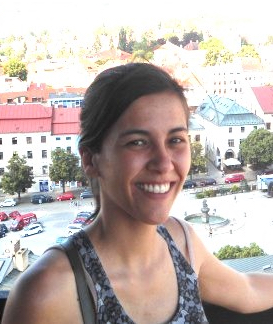 Paula Da Silva Tourinho
Paula Da Silva Tourinho
Plastic pollution is far and wide. All environments, from urban areas to the most isolated places, are contaminated by small plastic fragments known as microplastics. One main type of microplastic is the synthetic fibers released from textiles. These microplastic fibers are released from the washing machines in our home, reaching aquatic and terrestrial habitats. Once in the environment, microplastic fibers can adsorb other chemical pollutants, acting as a carrier for these pollutants. We aimed at investigating the adsorption of silver nanoparticles to polyester microplastic fibers and its toxic effects on aquatic and terrestrial organisms. Silver nanoparticles were chosen as the model pollutant for being vastly used in the textile industry due to its antimicrobial properties.
Yeast-derived Particles for Drug Delivery
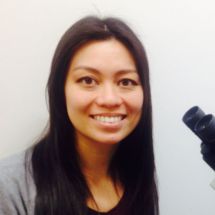 Gabriela Ruphuy Chan
Gabriela Ruphuy Chan
Yeast is one of the most commonly used ingredients in the food industry, but less commonly known is its potential use in drug delivery. The so-called yeast-derived beta glucan particles (GPs) are obtained from the cell wall of Saccharomyces cerevisiae (baker’s yeast), and because they are hollow and porous microparticles, they are suitable candidates as drug carriers. The mechanisms in which yeast glucan particles can potentially improve oral bioavailability of drugs will be briefly explained and discussed.
Temperature-responsive safer formulation of fungicide
To date fungicides are irreplaceable tool for combatting phytopathogenic fungi and for keeping high efficacy of agriculture. However, most of fungicides have several disadvantages, such as low water solubility, degradation under environmental impact, ecotoxicity, necessity of big amounts and repeated spraying. To solve these issues microencapsulation technique can be implemented. This allows to control and target the release, to eliminate active ingredient (AI) from aggressive environment, improve properties of AI, protect environment against toxicity of AI, etc. In this work fungicide pyraclostrobin was encapsulated to control its release via temperature change. In order to employ such temperature-responsive ability to fungicide formulation a phase change material (octadecane) was used as a core of microcapsule. Pyraclostrobin-loaded microcapsules were characterized using SEM, DLS, FTIR techniques, stimuli-responsivity was tested by means of in vitro tests with pathogenic culture (Fungal strain of Pyrenophora teres - CPPF-453) grown in Petri dishes. PyrMCs showed excellent antifungal effect above the melting point of octadecane (~28°C) and weaker effect below 28°C. Research results demonstrate a potential of temperature-responsive microencapsulated fungicide for successful utilization in agriculture.
Plant secondary metabolites and microbial degradation of structurally related xenobiotics
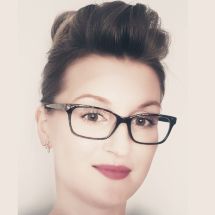 Magdalena Urbaniak
Magdalena Urbaniak
Rhizoremediation is one of the most effective processes of pollutants removal due to existing interactions in the rhizosphere between plant exudates, including plant secondary metabolites (PSMs), and microorganisms.
Although there is a considerable body of evidence that PSMs can cause changes in microbial community composition and stimulate microbial degradation of xenobiotics, the mechanisms of action on the molecular level (e.g. degradative gene induction) in relation to their chemical structure have not been fully understood yet. With this in mind, our aim is to acquire new knowledge on the role of PSMs in the microbial degradation of structurally related xenobiotics and in the expression level of the corresponding degradative genes.
Discrete Element Modelling of Colloidal Suspensions
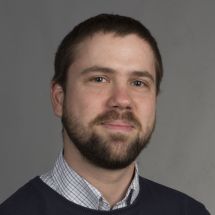 Alexandr Zubov
Alexandr Zubov
Discrete Element Method (DEM) is a popular method for modelling dynamics of granular media and powders materials. In this contribution we demonstrate how DEM can be utilized for prediction of complex phenomena arising in colloidal suspensions, e.g. particle coagulation, fouling, as well as estimation of suspension properties like viscosity and viscoelasticity.
High-performance Membranes for Separation of Biofuels
Prasad Talluri
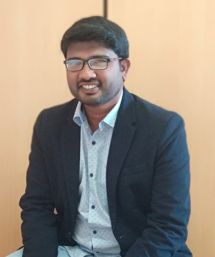 The transient and steady pervaporation of 1-butanol–water mixtures through a poly[1-(trimethylsilyl)-1-propyne] (PTMSP) membrane was studied to observe and elucidate the diffusion phenomena in this high-performing organophilic glassy polymer. Pervaporation was studied in a continuous sequence of experiments under conditions appropriate for the separation of bio-butanol from fermentation broths: feed concentrations of 1.5, 3.0 and 4.5 w/w % of 1-butanol in nutrient-containing (yeast extract) water, temperatures of 37, 50 and 63 °C, and a time period of 80 days. In addition, concentration polarization was assessed. As expected, the total flux and individual component permeabilities declined discernibly over the study period, while the separation factor (average β = 82) and selectivity towards 1-butanol (average α = 2.6) remained practically independent of the process conditions tested. Based on measurements of pervaporation transients, for which a new apparatus and model were developed, we found that the diffusivity of 1-butanol in PTMSP decreased over time due to aging and was comparable to that observed using microgravimetry in pure vapor in 1-butanol. Hence, despite the gradual loss of free volume of the aging polymer, the PTMSP membrane showed high and practically independent selectivity towards 1-butanol. Additionally, a new technique for the measurement and evaluation of pervaporation transients using Fourier transform infrared spectroscopy (FTIR) analysis of permeate was proposed and validated.
The transient and steady pervaporation of 1-butanol–water mixtures through a poly[1-(trimethylsilyl)-1-propyne] (PTMSP) membrane was studied to observe and elucidate the diffusion phenomena in this high-performing organophilic glassy polymer. Pervaporation was studied in a continuous sequence of experiments under conditions appropriate for the separation of bio-butanol from fermentation broths: feed concentrations of 1.5, 3.0 and 4.5 w/w % of 1-butanol in nutrient-containing (yeast extract) water, temperatures of 37, 50 and 63 °C, and a time period of 80 days. In addition, concentration polarization was assessed. As expected, the total flux and individual component permeabilities declined discernibly over the study period, while the separation factor (average β = 82) and selectivity towards 1-butanol (average α = 2.6) remained practically independent of the process conditions tested. Based on measurements of pervaporation transients, for which a new apparatus and model were developed, we found that the diffusivity of 1-butanol in PTMSP decreased over time due to aging and was comparable to that observed using microgravimetry in pure vapor in 1-butanol. Hence, despite the gradual loss of free volume of the aging polymer, the PTMSP membrane showed high and practically independent selectivity towards 1-butanol. Additionally, a new technique for the measurement and evaluation of pervaporation transients using Fourier transform infrared spectroscopy (FTIR) analysis of permeate was proposed and validated.
Bacterial extracellular vesicles and their functions in plants
Martin Janda
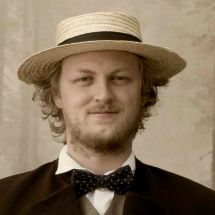 Vesiculation is a process of Gram-negative bacteria to release extracellular vesicles (EVs) into the environment. Bacterial EVs contain molecular cargo from the donor bacterium and play important roles in bacterial virulence and survival. In my project we were focused on the EV production by plant‑pathogenic Pseudomonas syringae pv. tomato DC3000 (Pto DC3000), the causal agent of bacterial speck disease. we demonstrated that Pto DC3000 produce EVs in planta. We characterized Pto DC3000 EV proteome. The potential contribution to Pto DC3000 plant infection of EV proteins was assessed using other in planta *omics data sets and plant treatments. These results point at roles for EVs in bacterial defenses and nutrient acquisition of Pto DC3000.
Vesiculation is a process of Gram-negative bacteria to release extracellular vesicles (EVs) into the environment. Bacterial EVs contain molecular cargo from the donor bacterium and play important roles in bacterial virulence and survival. In my project we were focused on the EV production by plant‑pathogenic Pseudomonas syringae pv. tomato DC3000 (Pto DC3000), the causal agent of bacterial speck disease. we demonstrated that Pto DC3000 produce EVs in planta. We characterized Pto DC3000 EV proteome. The potential contribution to Pto DC3000 plant infection of EV proteins was assessed using other in planta *omics data sets and plant treatments. These results point at roles for EVs in bacterial defenses and nutrient acquisition of Pto DC3000.
Theoretical modelling of X-ray processes: Probe of aqueous structure
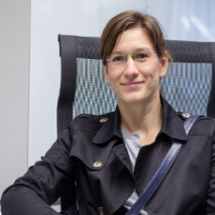 Eva Muchová
Eva Muchová
In X-ray photochemistry we focus on modelling processes that are induced by high energy radiation. This field has witnessed unprecedented importance because of novel experiments at synchrotrons of free electron lasers facilities. The possible applications range from radiation therapy to control of chemical reactivity.
Due to its novelty, theoretical modelling lags behind experiments. We assemble and modify theoretical tools to help us understand processes in which molecules in solutions deactivates after being irradiated by X-rays. We investigate if these relaxation processes can be a basis of novel Auger-type X-ray spectroscopies which would allow us to study the “chemical environment” in solutions.
Past conferences
[submenuno] => [urlnadstranka] => [newurl_domain] => 'www.vscht.cz' [newurl_jazyk] => 'en' [newurl_akce] => '/research/events/science-rendezvous-en' [newurl_iduzel] => [newurl_path] => 1/4111/959/1017/2403/65233/46243 [newurl_path_link] => Odkaz na newurlCMS [iduzel] => 46243 [platne_od] => 18.07.2022 17:18:00 [zmeneno_cas] => 18.07.2022 17:18:05.836326 [zmeneno_uzivatel_jmeno] => Jan Kříž [canonical_url] => [idvazba] => 78078 [cms_time] => 1714177055 [skupina_www] => Array ( ) [slovnik] => Array ( ) [poduzel] => stdClass Object ( [52817] => stdClass Object ( [nazev] => Science Rendezvous 2019 [seo_title] => Science Rendezvous [seo_desc] => [autor] => [autor_email] => [perex] =>Second Science Rendezvous - conference with short introductory talks about scientific topics followed at UCT Prague. The event takes place on Thursday 14th of February from 1 pm in Lecture hall BI.
[ikona] => [obrazek] => 0001~~K0rNS0mtKssvLVbQVShPTQKSxSVFhxfmZScCmUYGhpYA.png [ogobrazek] => [pozadi] => [obsah] =>Scientific topics
| Applied statistics in computational spectroscopy | Ing. Štěpán Sršeň |
| BioMates: from biomass to biofuel | Ing. Miloš Auersvald |
| Chemical robots for targeted drug delivery | Ing. Denisa Lizoňová |
| Chiroptical spectroscopy: insight into molecular structure | Ing. František Králík |
| Electrocoagulation of Microalgae Chlorella | Ing. Simona Lučáková |
| Enhancing the culturability of soil bacteria | Ing. Marco A. López Marín |
| Excited states of coordination compounds | Ing. Martin Pižl |
| Magical effect of transition metals in organic synthesis | Ing. Peter Polák |
| Natural gas - green fuel or just another fossil? | Ing. Tereza Navrátilová |
| Targeting phorbol derivatives toward cancers | Ing. Tomáš Zimmermann |
| Tertiary phosphorus precipitation in wastewater treatment | Ing. Lenka Miklíková |
Annotation
Applied statistics in computational spectroscopy
Ing. Štěpán Sršeň
I will discuss possible applications of machine learning approaches in chemistry, with emphasis on spectroscopic data modelling. One of the directions in our research is quantitative modelling of electronic spectra. Electronic absorption spectra are, for example, important input for rate constants calculations of photochemical reactions. Chemical theory is vital both for interpretation of experimental data and for modelling spectral data for molecules where measurements are difficult. However, it is still not possible to use high-level quantum methods for larger molecules because of their computational demands. We overcome these limitations by using applied statistics such as machine learning.
BioMates: from biomass to biofuel
Ing. Miloš Auersvald
To meet the expected requirements of the proposed EU Renewable Energy Directive for the next decade (RED II), it is necessary to increase the availability of second-generation biofuels. One promising way of doing this involves using mobile ablative fast pyrolysis to transform straw into bio-oil. To obtain suitable feedstock for co-processing in a typical refinery, bio-oil properties need to be upgraded. The main task of our department in BioMates project is the catalyst optimization and subsequent testing of their activity for bio-oil hydrotreatment. We also work on the improvement of analytical methods for detailed characterisation of bio-oil and the products after its upgrading.
Chemical robots for targeted drug delivery
Ing. Denisa Lizoňová
A specific delivery of a drug to the target area leads to an improved effect while minimizing undesired effects to the body. Non-targeted liposomes are nowadays commercially available for the cancer treatment. The effectivity of such system can be significantly increased by adding a targeting moiety, e.g. antibody. The feasibilities of the antibody coupling and other surface modifications of the liposomes in order to increase their accumulation in the tumor will be briefly explained and discussed.
Chiroptical spectroscopy: insight into molecular structure
Ing. František Králík
Chiroptical spectroscopy represents a modern tool for a detailed analysis of chiral molecules in a solution. It has a promising potential in the field of forensic and pharmaceutical analysis as the absolute configuration as well as the 3D structure play a key role in understanding biological activity and mechanism of action of drugs and pharmaceuticals. The Laboratory of Chiroptical Spectroscopy at UCT Prague has employed three most important chiroptical methods: electronic and vibrational circular dichroism and Raman optical activity. Their application in the analysis of chiral drugs and pharmaceuticals will be presented.
Electrocoagulation of Microalgae Chlorella
Ing. Simona Lučáková
This study was focused on harvesting of Chlorella vulgaris, well-known microalga with use in nutrition and health care. Harvesting (separation of cells from a culture medium) is an important part of the production process. It was estimated that 30 % of the production costs is the cost of biomass separation. One of the possible ways of decreasing harvesting costs is pre‑concentration of microalgae suspension by electrocoagulation followed by one of common separation methods (e.g. sedimentation or flotation). The principle of this method is forming well-sedimenting aggregates called flocks, which are easy to separate from the cultivation medium.
Enhancing the culturability of soil bacteria
Ing. Marco A. López Marín
According to estimations, only around 1% of the microorganisms of Earth are culturable. Several strategies have been employed to improve cultivation, among which are the use of growth-promoting factors. Micrococcus luteus secretes a growth-promoting factor called Resuscitation Promoting Factor (Rpf), which helps resuscitate cells from dormancy. A method for extracting and culturing soil bacteria using Rpf from M. luteus supernatant (SRpf) is proposed, aiming to increase bacterial diversity observed on solid media. The goal of this approach is to allow more members of the soil community to be cultured, among them possibly as-yet-uncultured bacteria playing important degradative roles in the environment.
Excited states of coordination compounds
Ing. Martin Pižl
Excited states (ES) of diverse compounds are studied for their photophysical characterization and application in catalysis, solar cells, electron pathways in proteins and activation of small molecules (CO2). Transition metal complexes are widely used for these studies in electronically ES. Description of electronic states of molecules is achieved by time-resolved infrared spectroscopy. However, vibrational ES is significant tool to study anharmonic and solvent effects. Vibrational energy relaxation in ground and electronically excited states is studied by 2-dimensional infrared spectroscopy and transient 2-dimensional infrared spectroscopy, respectively. ES characterization will be demonstrated on examples of Re, Ru and Ir complexes and modified azurin.
Magical effect of transition metals in organic synthesis
Ing. Peter Polák
Synthetic organic chemistry has been revolutionized by the invention of transition metal-catalyzed cross-coupling reactions where two organic fragments are joined together with the aid of a metal catalyst. One of the fragments must contain a leaving group, usually a halogen atom but other types of leaving groups are known e.g. sulfonates, carbamates, esters, ethers or hydrogen atom. Research interest in our laboratory is focused on cross-coupling reactions where phosphate group serves as a leaving group. We have successfully applied cross-coupling reactions of phosphates for the synthesis of biologically active tetrasubstituted alkenes and polysubstituted indoles, polythiophenes for organic semiconductors and synthesis of valuable [n]dendalenes.
Natural gas - green fuel or just another fossil?
Ing. Tereza Navrátilová
Natural gas is a fossil fuel but apart from any other fossil resources it does not produce ash or any other solid particles during combustion and has the lowest level of carbon dioxide on one unit of released energy. It is commonly used for heating households, powerhouses and public transport. Our research pursues the use of compressed natural gas in public transport but mainly focuses on the issues of its storage in containers filled with solid adsorbents.
Targeting phorbol derivatives toward cancers
Ing. Tomáš Zimmermann
Phorbol esters are natural products with biological activity such as proinflammatory, proapoptotic, tumor promoting and causing increase in cytosolic Ca2+. Phorbol esters activity takes place via activation of protein kinase C (PKC).
PKC plays significant role in several important cell signal transduction pathways. The biological effect seems to be strongly affected by which PKC isozyme is activated.
We developed phorbol ester prodrugs so that we can maximize the proapoptotic effect and minimize side effects. We used peptides that are specifically cleaved in cancer tissue which were previously utilized with success after being coupled to natural cytotoxin thapsigargin.
Tertiary phosphorus precipitation in wastewater treatment
Ing. Lenka Miklíková
Our Scientific Work Group is engaged in research of removal residual phosphorus from the effluent of urban wastewater treatment plants. Phosphorus, as the one of the nutrients, triggers vigorous growth of cyanobacteriae, reduces dissolved oxygen content, suffocates fish populations, and complicates water purification. Therefore, the attention should be drawn to this problem and pay much attention to develop new or improve the available wastewater treatment methods to remove this pollutant from a waste water and to work towards improved ecology of the water environment to the greatest extent. The aim of our work is to assess and design a new environmental technology for an urban wastewater treatment plants that would help to reduce the phosphorus in environment. The technology consists of tertiary phosphorus precipitation and separation of precipitate with membrane filtration.
Past conferences
[urlnadstranka] => [poduzel] => Array ( ) [iduzel] => 52817 [canonical_url] => [skupina_www] => Array ( ) [url] => /research/events/science-rendezvous-en/science-rendezvous-2019-en [sablona] => stdClass Object ( [class] => stranka_obrazek_vertical [html] => [css] => [js] => [autonomni] => 1 ) ) [65237] => stdClass Object ( [nazev] => Science Rendezvous 2018 [seo_title] => Science Rendezvous 2018 [seo_desc] => [autor] => [autor_email] => [perex] =>The first year of the showcase of scientific teams operating at UCT Prague took place on 14 February 2018. Here is a recording of the individual performances.
[ikona] => [obrazek] => 0001~~C07OTM1LTlUISs1LSa0qyy8tBgA.png [ogobrazek] => [pozadi] => [obsah] =>Scientific topics
Recordings
Resource recovery from wastewater through innovative technologies
doc. Bartáček
Wastewater has been increasingly seen as a source of materials and energy rather than waste that must be disposed of. Our group consistently contributes to this much needed paradigm shift by developing innovative and sustainable resource recovery technologies. The core process studied in the group is anaerobic digestion of wastewater and sludge, i.e. recovery of chemical energy from wastewater in the form of biogas. We focus on process optimization, biogas upgrading and the post-treatment of liquid anaerobic effluent. We work on nitrogen recovery through N2O production or the production of methanol from dissolved methane. Last, but not least, we study recovery and re-use of water in the systems for decentralized wastewater management. We cover both basic and applied research, the former being represented by detailed microbiological and physiological studies and the latter by bioreactor experiments in lab-, pilot- and full-scale.
Chasing the retrovirus
doc. Ulbrich
Viruses are relatively simple infectious pathogenic particles consisting of protein shell and viral genome, either DNA or RNA. Since they cause many severe, very often life-threatening diseases, their inhibition is very important scientific target and detailed understanding of virus life cycle steps is necessary for the designing of new antivirals. Because viruses are able to multiply only in the host cell, it is important to understand not only the virus composition, but also the whole machinery that they use for their replication. Our research focuses on the study of selected life cycle steps of retroviruses.
Photoredox catalysis with organic dyes and visible light – way towards new chemical reactions
prof. Cibulka
Photoexcitation allows chemical transformations that are not accessible by conventional methods. Use of visible light combined with a photocatalyst even improves classical photochemical methodologies with UV light avoiding side reactions and making photochemistry available for most laboratories. Nowadays, photoredox catalysis with organic molecules is of growing interest because of low costs of organic dyes. Boundaries of organic photoredox catalysis will be demonstrated on examples of application of flavin derivatives, known as prominent natural chromophores (e.g. riboflavin - vitamin B2 of flavin adenine dinucleotide - FAD).
Role of secondary plant metabolites in the ecology of soil microorganisms
doc. Uhlík
Soil microorganisms are the decomposers of photosynthetically-derived organic compounds. Among the plant-derived organic matter, secondary plant metabolites – a wide array of compounds, including terpenes and phenolics – are predicted to be of outstanding importance in controlling soil ecology. The goal of our work is to elucidate the role of secondary plant metabolites in the ecology of soil microorganisms, including whether and how secondary plant metabolites control soil microbial community structure and increase the contaminant biodegradation potential in the microbial community.
Radical improvements in preparation of novel targeted gas separation membranes
doc. Friess
The tremendous potential of the membrane separation processes (MSP) has been recognized during past decades. Compared to traditional separation processes (e.g. cryogenic distillation, scrubbing or pressure swing adsorption), MSP represent modern separation technique with low energy and space demands. Currently, new membranes based on hyperbranched polyimides, polymers with intrinsic microporosity or graphene-oxide are representative novel materials for targeted gas separation of hydrogen, methane or nitrogen from CO2. Contrarily, hyper CO2-selective polymeric membranes are mostly based on polyethylene oxide-based membranes or ionic liquid-based membranes with enhanced preferential CO2 sorption thus enhancing CO2 permeability compared to the other gases.
Research on post combustion carbon dioxide capture
dr. Staf
Besides intensive discussion about causes of global climate changes and their impacts there is in fact public consensus that new methods leading to elimination of CO2 emissions should be developed. The hereby presented research deals with sorption of this greenhouse gas from flue gases via physical adsorption or chemisorption. The aim of our activities is to provide effective and economically acceptable material, allowing implementation of the carbon capture technology during retrofitting the existing power and heating plants. For this purpose, various sorbents have been tested, namely natural limestones, hydrotalcite-like compounds and activated fly ashes.
Methanation of carbon dioxide as a technology for the production of synthetic natural gas
dr. Hlinčík
Renewable energy sources (wind and solar power plants) are strongly dependent on actual weather conditions which causes difficulties with the steering of the electricity distribution grid. The concept of Power to Gas (PtG) technologies is interconnecting processes of the electricity production with the gas storage and distribution by converting the excess electricity into chemical energy - methane. Project is focusing on study of the catalytic methanation of carbon dioxide as a part of PtG technologies. Electricity conversion consists of two stages where during the first step, hydrogen is produced by water electrolysis and during the second step, hydrogen and carbon dioxide form methane in the catalytic reactor.
Chemistry and catalysis in two dimensions
doc. Sofer
Enormous rise of interest in 2D materials has started by the isolation of graphene in 2004 – a single layer of carbon atoms. Fascinating properties of graphene rapidly stimulated the research of the other 2D materials. The spectrum of 2D materials is growing rapidly and covers many materials, which are generally based on strong in-plane covalent bonds and weak interlayer interactions. Besides semiconducting graphene, there are also insulating 2D materials like hexagonal boron nitride, semiconductors like chalcogenides of indium and gallium and also unique catalytic materials like layered carbides and transition metal dichalcogenides, which can be used as a cheaper alternative to precious metal catalysts.
Open challenges: energy storage, nano-cellular foams, colloidal dispersions
prof. Kosek
Three open challenges for our research laboratories will be briefly introduced: (i) enery storage employing the concept of flow batteries and organic redox pairs, (ii) micro- and nano-cellular polymeric foams including systematic understanding of their morphology evolution, and (iii) modeling of coagulation, fouling and rheology of colloidal dispersions in the context of multi-scale modeling and Industry 4.0 activities.
Current research trends in metallic materials at UCT
doc. Novák
Metallic materials are still among the most important technical materials due to their irreplaceable properties. Department of Metals and Corrosion Engineering deals with metals in all aspects covering their production, processing, determination of their properties, corrosion testing and recycling. The presentation covers hot topics, currently being investigated in these fields. Extraction of metals from non-conventional raw materials, preparation of nanostructured metals by modern powder metallurgy techniques, development of new metallic biomaterials and solution of current corrosion problems in technical practice are briefly presented.
Supramolecular chemistry of calixarenes and related compounds
prof. Lhoták
Calixarenes/thiacalixarenes represent a family of macrocyclic compounds with many unique properties including their ability to recognise and complex various ions and/or molecules. The precisely defined size and shape of their cavities together with well-established chemistry make these compounds a good choice for the role of building blocks and molecular scaffolds in the design of more elaborated supramolecular systems. The tuneable 3D shapes of the molecules, together with the opportunity to introduce selected functional groups into exactly defined mutual positions, allow for their application as highly selective ligands and receptors for many chemical species.
Reduction of the process contaminants 3(2)-MCPD and their esters content in refined palm oil
dr. Hrbek
3-chloropropane-1,2-diol (3-MCPD) and some other chloropropanols represent an important group of food processing contaminants. The first report on 3-MCPD occurrence in acid-hydrolysed vegetable proteins and soy sauces was documented by professor Velisek (1978) from UCT Prague. Relatively high amounts of these “emerging” processing contaminants were found especially in refined palm oil. 3‑MCPD is considered as a probable carcinogen. 3-MCPD is formed from chlorine-containing compounds. The aim of this research is to find, characterize and eliminate these chlorinated precursors to prevent the formation of MCPD during palm oil refining.
[urlnadstranka] => [poduzel] => Array ( ) [iduzel] => 65237 [canonical_url] => [skupina_www] => Array ( ) [url] => /research/events/science-rendezvous-en/science-rendezvous-2018-en [sablona] => stdClass Object ( [class] => stranka_obrazek_vertical [html] => [css] => [js] => [autonomni] => 1 ) ) ) [sablona] => stdClass Object ( [class] => stranka_obrazek_vertical [html] => [css] => [js] => [autonomni] => 1 ) [api_suffix] => )
